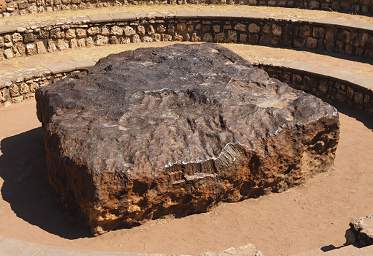
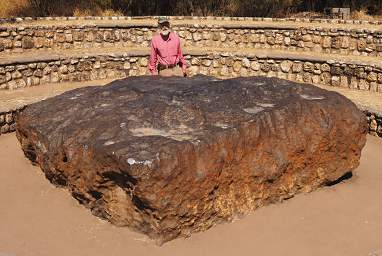
Gary and the Meteorite
We left Waterburg National Park heading northeast; our goal was Mahango National Park, at the start of the Caprivi Strip.
Our map said the largest meteorite in the world was more or less on our way, so we detoured down a side road.
According to the sign, the Hoba meteorite is the largest known meteorite in the world, and came raining down from the heavens about 80,000 years ago. It weighs approximately 50 tons and is composed of 82% iron, 16% nickel, and 0.8% cobalt. It is about three meters long and up to one meter thick. It's obviously not even close to being the largest meteorite known to hit the earth; it's just the largest one still around for anyone to see all in one piece. It was discovered in 1920; the site was declared a national monument in 1955 with the permission of the then owner of the property.
 |
 |
| Meteorite | That's a big hunk of rock to fall from the sky!
Gary and the Meteorite |
An unexpected bonus was the meteorite site was full of birds; it was a treat to just wander around and enjoy them.
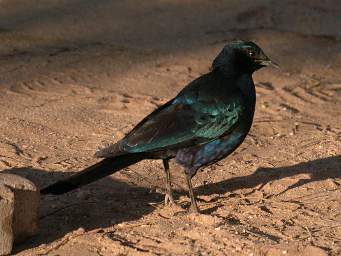 |
| Xxx Starling |
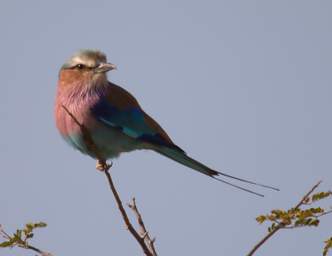 |
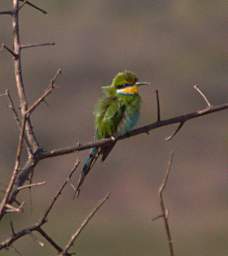 |
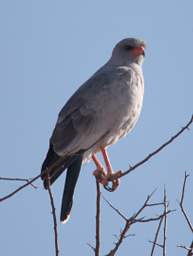 |
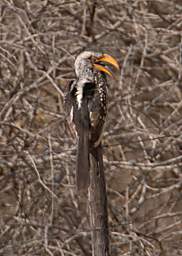 |
| Lilac Breasted Roller | Swallow Tailed Bee Eater | Pale Chanting Goshawk | Southern Yellow Billed Hornbill |
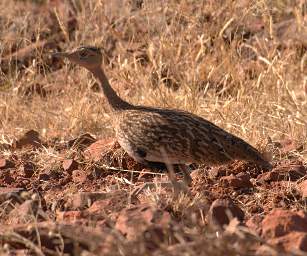 |
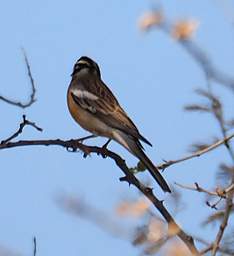 |
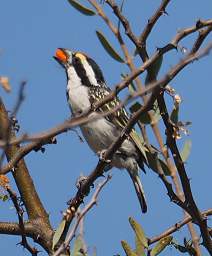 |
| Red Creasted Koorhan | Xxx Cape Bunting | Acacia Pied Barbet |
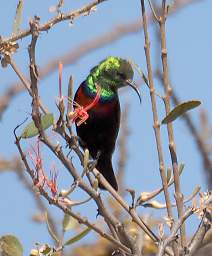 |
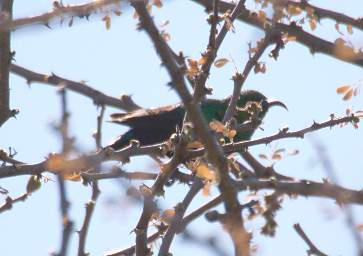 |
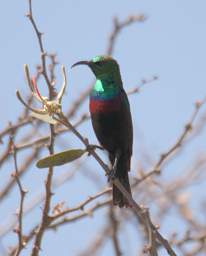 |
| Miombo Double Collared Sunbird | ||
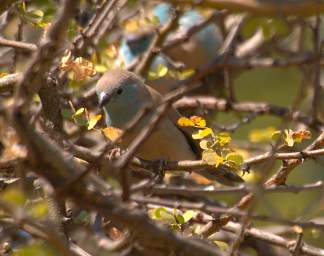 |
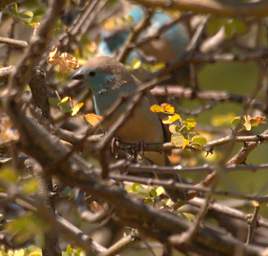 |
| Blue Waxbill | |
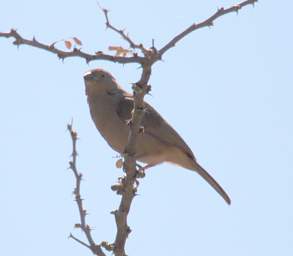 |
| Xxx |
As we continued on, the hilly farm country of the area around the meteorite and the town of Grootfontein gave way to flatlands; prosperous farms were replaced by subsistence holdings. Our plan was to camp at Mangetti National Park, and arrive at Mahango the next day. However, while the park may exist, it is certainly not well marked. We drove by where it was supposed to be and saw no roads for access and no signs; we then turned around and tried again, to no avail. We covered about a 20km stretch of highway looking for it, then decided to keep on going.
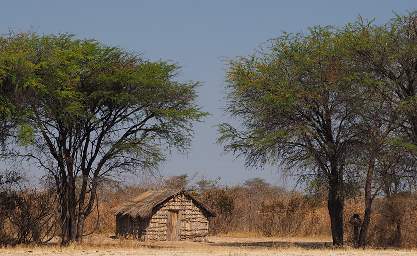 |
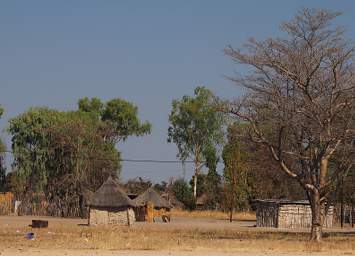 |
| Houses in the Kavango Region | |
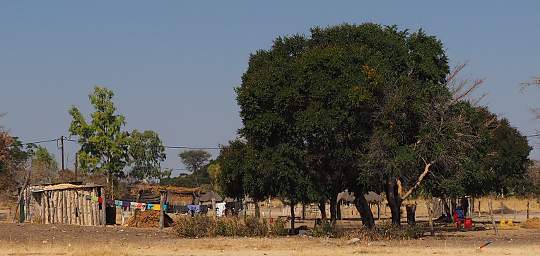 |
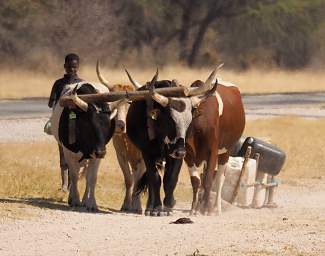 |
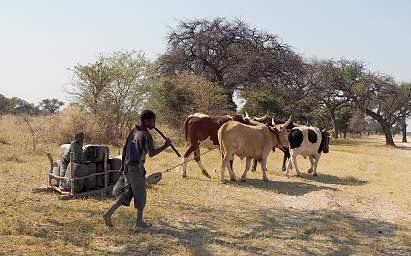 |
| Boys Hauling Water on Ox Sled | |
As we neared the northern border, we left the highway to drive the back road along the Okavango River. The river is the border between Namibia and Angola; it then crosses Namibia near the beginning of the Caprivi Strip and disappears into the Kalahari Desert in Botswana.
 |
 |
| Okavango R | |
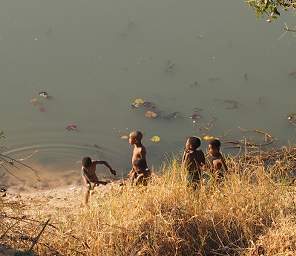 |
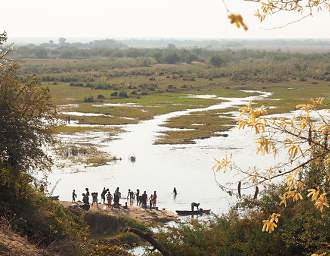 |
| Boys Playing | Swimming in the Okavango River |
It was the dry season, and we kept seeing trees which looked like they were showing fall colors. It turned out they had lost their leaves already (it was, after all, Winter...); what we were seeing was usually seed pods.
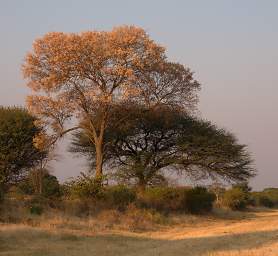 |
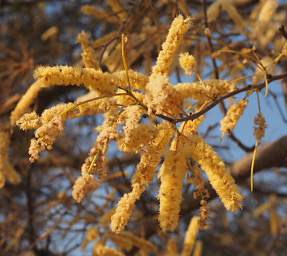 |
| Tree | Tree Seeds |
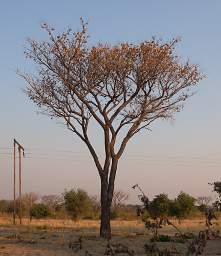 |
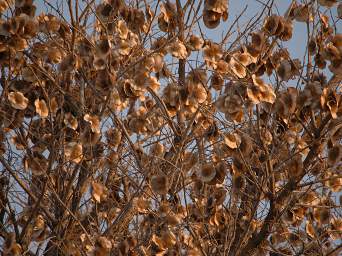 |
| Tree | Tree Seeds |
 |
| Women Carrying Water |
We came upon a Long-tailed Widowbird and I spent a while chasing it around trying to get a good picture; I failed.
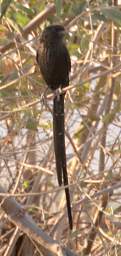 |
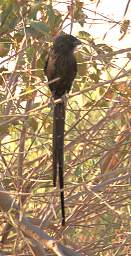 |
| Long Tailed Widowbird | |
As in many other parts of Namibia, millet is the most important crop. We saw bundles of millet everywhere along the road either being put in storage, for sale, or moving to market.
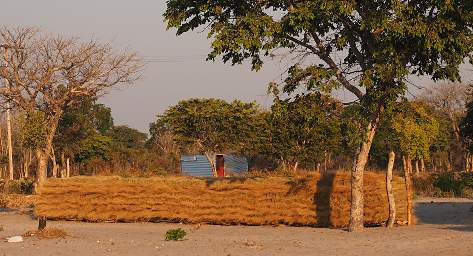 |
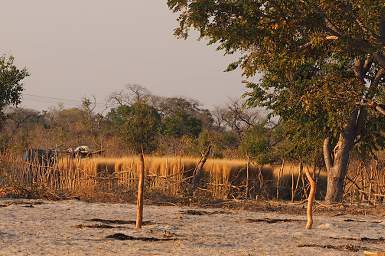 |
| Millet | |
We arrived at the bridge across the Okavango River where we would turn south to Mahango National Park at dusk. Bradt's Guide to Namibia (much better than the Lonely Planet Guide) indicated there was a community campground run by the native San people nearby. "N//goabaca" Camp is located near the river just past the bridge. The camp host, a local San man, advised us to pitch our tent on the platform provided, and to "stay in tent and keep zipped up" after dark. Apparently there were Black Mambas around.
I had to get up in the middle of the night to pee, which meant I had to leave the platform. I made sure I had my light and looked around hoping to see a black mamba, but didn't.
 |
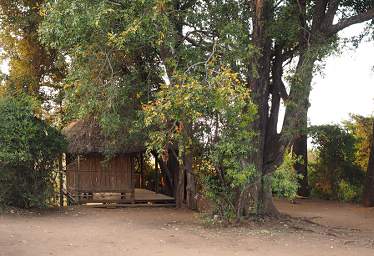 |
| N//goabaca Camp | |
The next morning we crossed back over the Okavango and drove south to Mahango National Park.
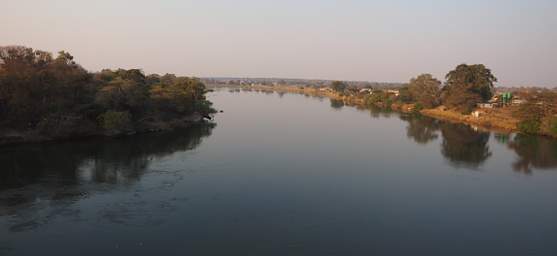 |
| Okavango River |
We entered Mahango National Park and turned off on the park road which parallels the river. It wasn't long before we started seeing birds and mammals.
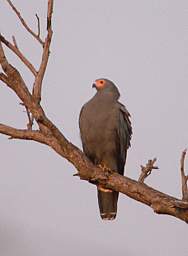 |
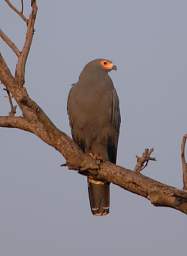 |
| Bateleur Eagle | |
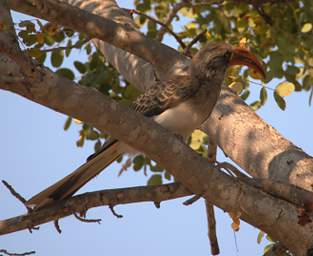 |
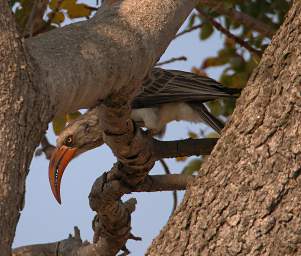 |
| Bradfield's Hornbill | |
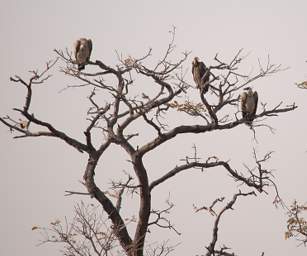 |
| White Backed Vultures |
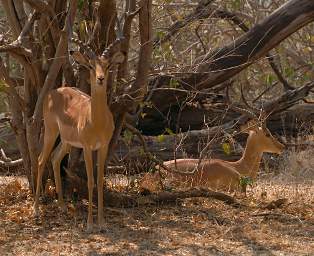 |
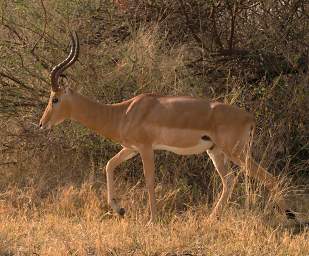 |
 |
| Impala | ||
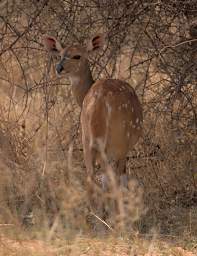 |
| Bushbuck |
 |
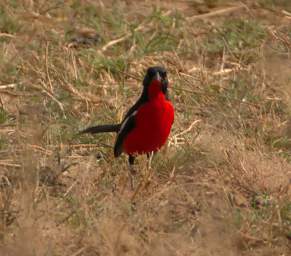 |
| Crimson Breasted Shrike | |
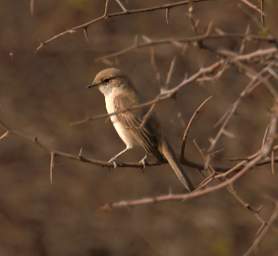 |
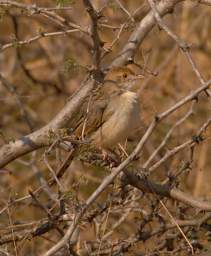 |
| Marico Flycatcher | Xxx Imm Xxx Cuckoo |
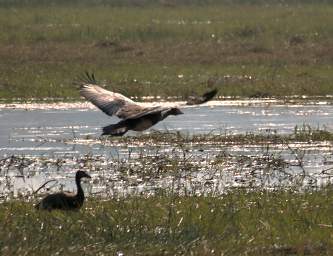 |
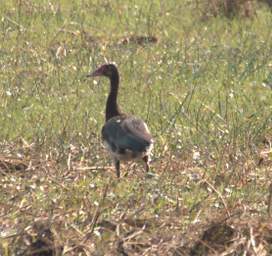 |
| Egyptian Goose | Spur Winged Goose |
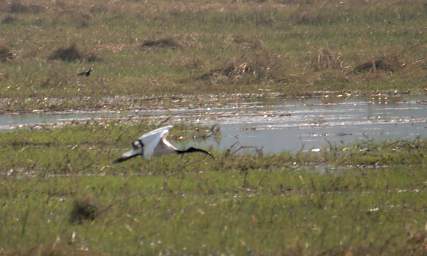 |
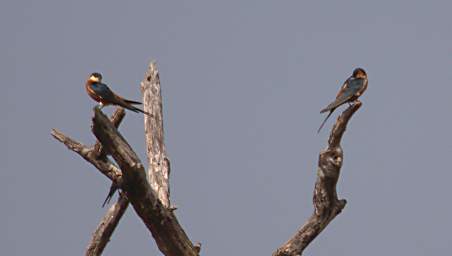 |
| African Sacred Ibis | Xxx Swallow |
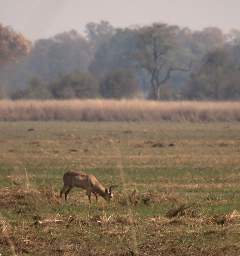 |
| Southern Reedbuck |
 |
| Baboons |
One of the highlights of our day was a small group of Green Wood Hoopoes we found. They are wonderfully colorful birds. With a diet consisting mostly of insects, these were hopping around the tree probing the bark for food. At least I think that's what they were doing...
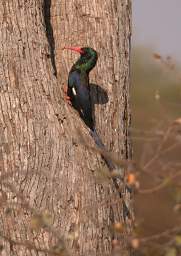 |
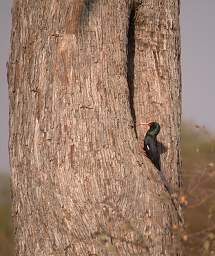 |
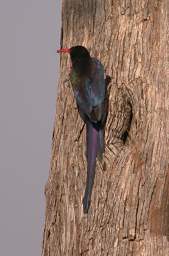 |
| Green Wood Hoopoe | ||
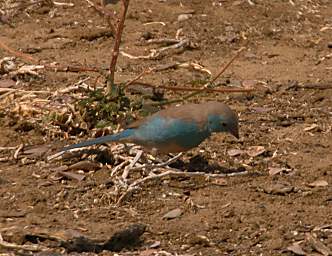 |
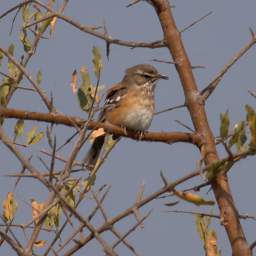 |
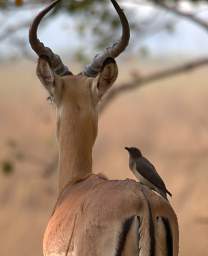 |
| Blue Waxbill | Xxx Bearded Scrub Robin | Xxx White Breasted Cuckoo Shrike |
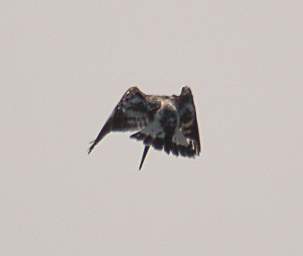 |
| Pied Kingfisher |
 |
| Mahango |
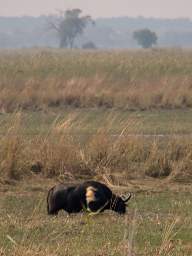 |
| Cape Buffalo |
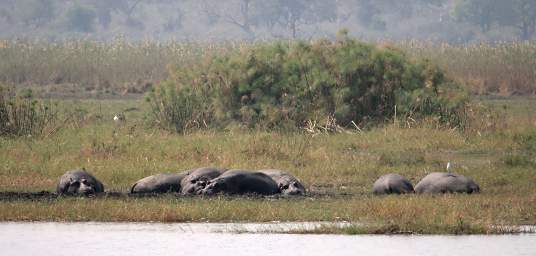 |
| Hippos |
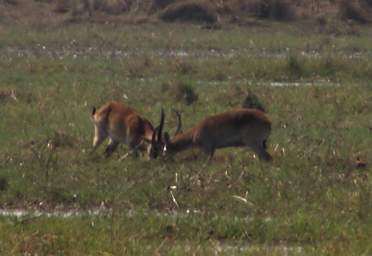 |
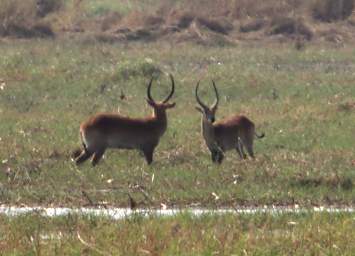 |
| Lechwe Fighting | Lechwe |
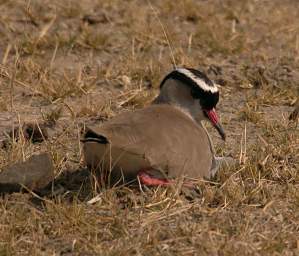 |
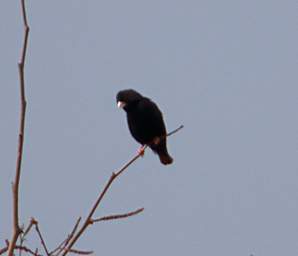 |
| Crowned Lapwing | Village Indigobird |
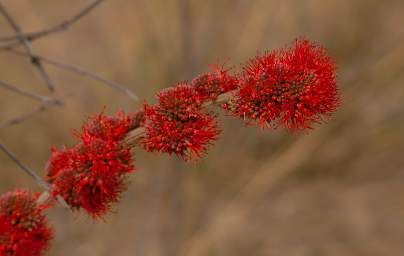 |
| Tree Xxx Blossom Red |
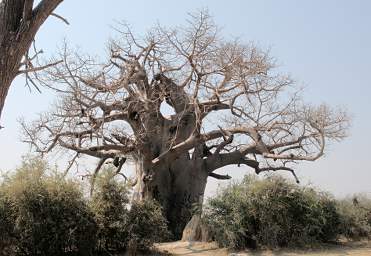 |
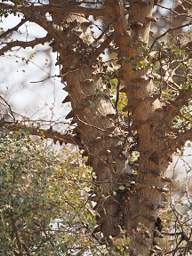 |
| Baobab | Xxx Shark Tooth Bark |
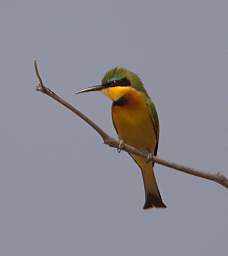 |
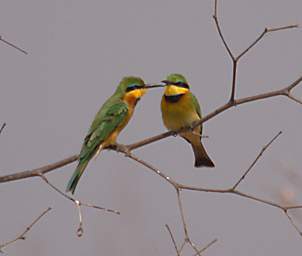 |
| Little Bee Eater | |
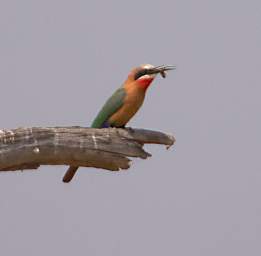 |
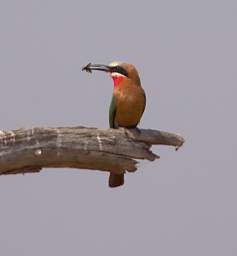 |
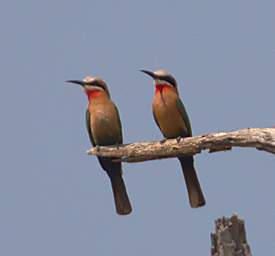 |
| White Fronted Bee Eater | ||
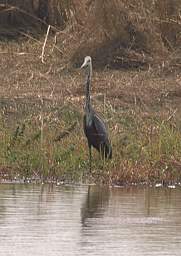 |
| Golaith Heron |
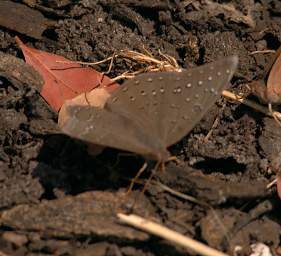 |
| Moth |
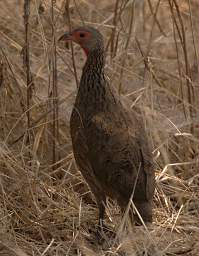 |
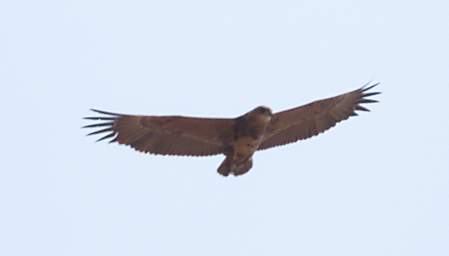 |
| Swainsons Spurfowl | Xxx |
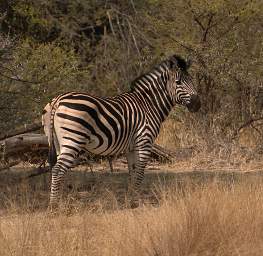 |
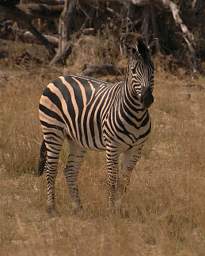 |
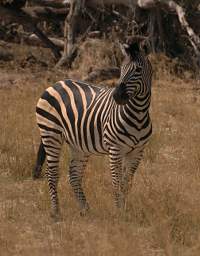 |
| Zebra | ||
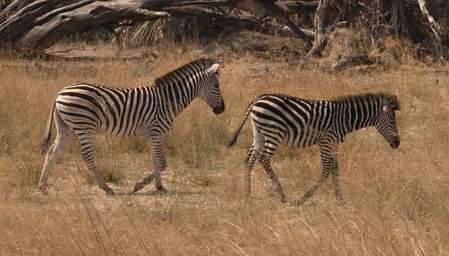 |
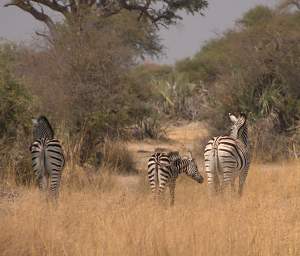 |
| Zebra | Zebra Butts |
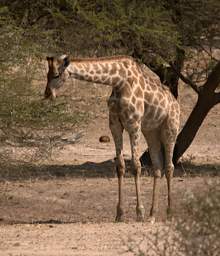 |
 |
| Giraffe | |
There is no camping allowed in the park, and visitors have to be out be 18:00. We headed for Ngepi Camp, something that sounded good in our guide. We were hoping maybe to stay in one of the tree-houses, but they were all booked. But the riverside tent camping places were great.
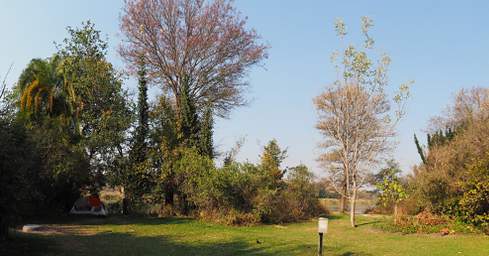 |
| Ngepi Camp |
We didn't bother with the fly for the tent the whole time we were traveling. The chance of rain was pretty much zero, and it was great to look up and see the stars. It was great to go to sleep to the sound of birds, frogs, crickets, wart hogs, hippos, and whatever else was around; and wake up to the same.
On the way into camp we came across this tree that had huge grapefruit-sized fruits; we never did find out what it was, and whether or not the fruits were edible.
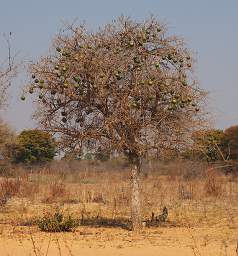 |
| Tree with Big Round Fruit |
Right before camp we came across a Pied Kingfisher where the road crossed an intermittent creek / small overflow branch of the river.
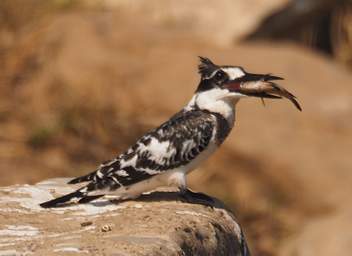 |
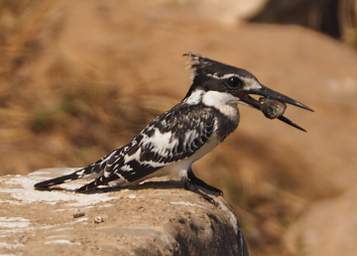 |
| Pied Kingfisher | |
 |
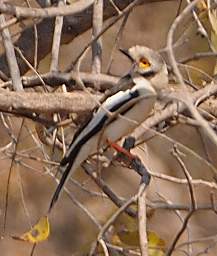 |
| White Creasted Helmetshrike | |
The camp had interesting showers which were solar powered with a "donkey" backup. I don't know why they're called "donkey" heaters -- they're just a 55 gallon drum with a fire underneath them and water piped through them. It was great just being outside to shower in the warm dry air instead of in some closed-up building.
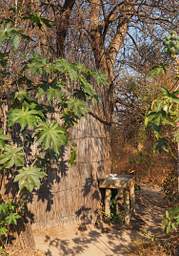 |
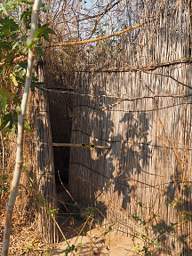 |
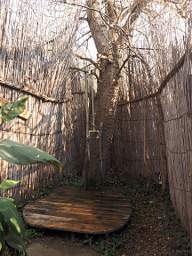 |
| Washbasin | Shower Entrance | Shower |
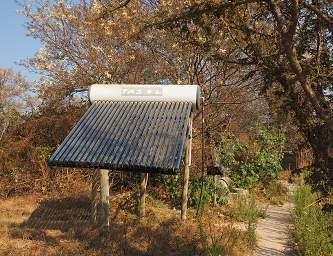 |
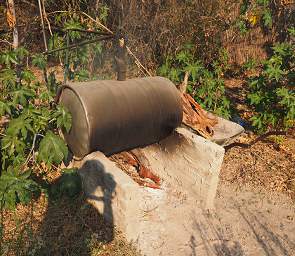 |
| Solar Water Heater | "Donkey" Water Heater Backup |
When we got to camp, our campsite was full of a variety of birds; it was difficult to try and ignore them and setup camp.
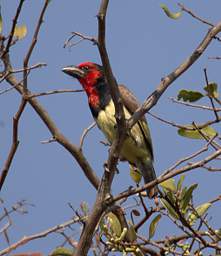 |
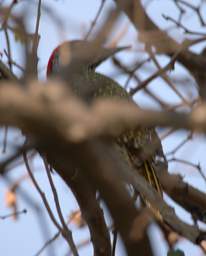 |
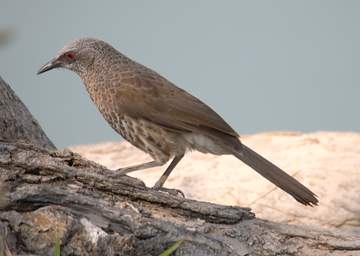 |
| Black Collared Barbet | Golden Tailed Woodpecker | Hartlaubs Babbler |
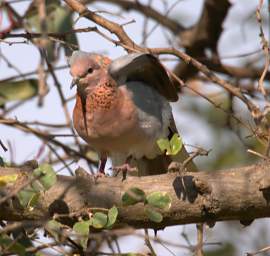 |
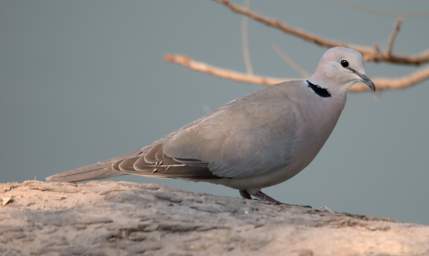 |
| Laughing Dove | Cape Turtle Dove |
 |
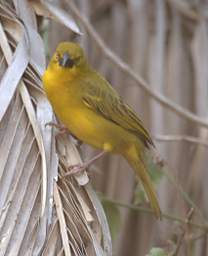 |
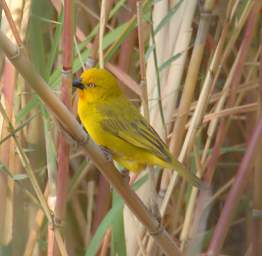 |
| African Golden Weaver | ||
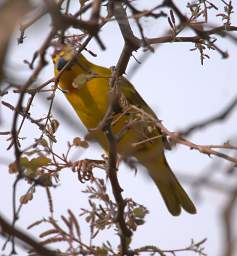 |
| Xxx African Golden Weaver |
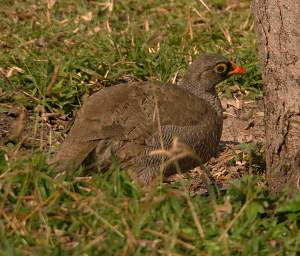 |
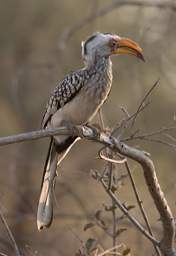 |
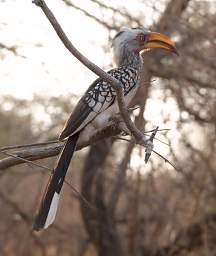 |
| Red Billed Spurfowl | Southern Yellow Billed Hornbill | |
The next morning we headed back to the park. We wanted to drive a longer loop road to the west, but because of stretches of sand it required a 4WD vehicle. We couldn't do that, but we could go about 6km to a watering hole.
At the water hole there was a small building which served as a blind; but our bright white rental car had to be parked in full view. It was worth the drive; elephants started arriving shortly after we did. They came from all directions; singly, in twos, and in small groups.
 |
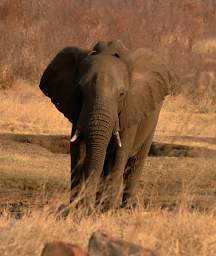 |
| Elephant | |
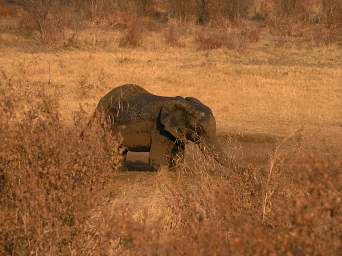 |
 |
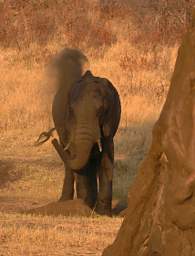 |
| Bathing in a Mudhole | Dustbath | |
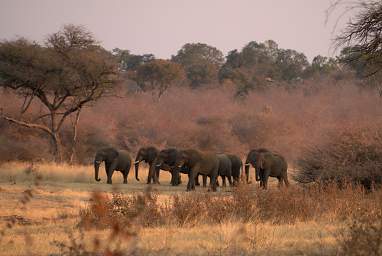 |
 |
| Elephants approaching the Waterhole | |
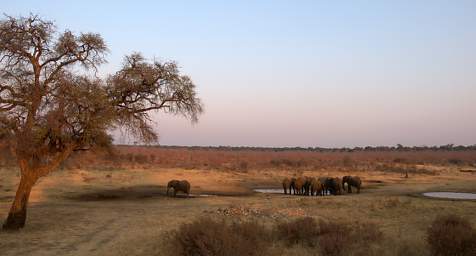 |
| At the Waterhole |
 |
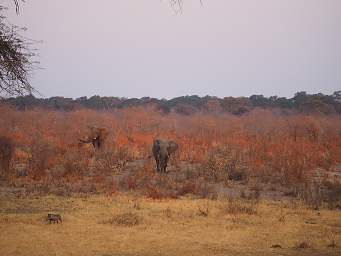 |
| Approaching the Waterhole | |
As you can see from the photo below, the park service has hardened the edge of the waterhole with a concrete apron. I'm not sure why they do this. It seems to me these animals have evolved for thousands of years in this environment, and the waterhole and them should all get along just fine without any human intervention. It may be more an accomodation for tourists using the blind; or maybe they just don't like the looks of a natural messy waterhole, and want to tidy it up. The only time I've known man-made messing with a waterhole was a benefit are situations where domestic farm animals mess them up, which is quite a bit different from a situation where native wildlife mess them up. In the former case, the waterhole is in a different state in natural conditions; in the latter, it's the way it's supposed to be. But then I'm not a waterhole biologist...
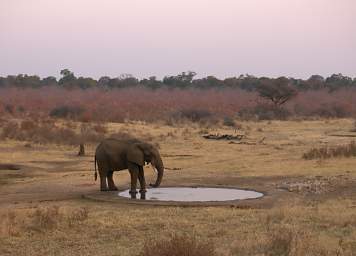 |
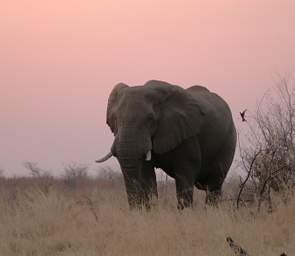 |
| At the Waterhole | |
There were quite a few birds at the waterhole, but not a lot of variety. All morning long large flocks of doves would fly in and then disperse. I had read about people going to Mexico to shoot doves in situations like this but I'd never actually seen birds flying in and out in such profusion.
 |
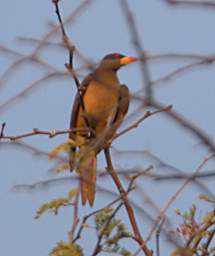 |
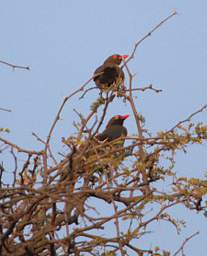 |
| Meyers Parrot | Yellow Billed Oxpecker | Red Billed Oxpecker |
One of the reasons we chose to visit the strip is to see Roan Antelope and Sable Antelope. Just as we were about to leave, a lone Roan Antelope started very cautiously approaching the waterhole. He was extremely wary. He would take a few steps forward then pause for long periods of time without moving, just looking around. He didn't see us, but he definitely saw our white rental car in a place where nothing was supposed to be. Eventually he decided it was too risky, and headed off into the bush in another direction.
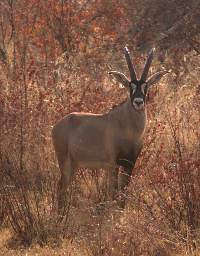 |
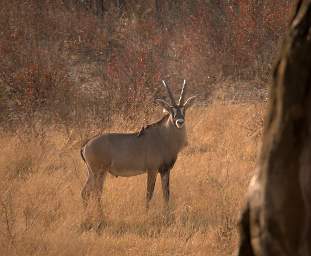 |
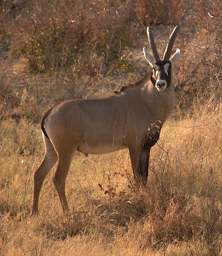 |
| Roan Antelope | ||
 |
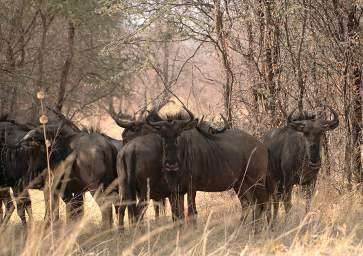 |
| Wildebeests | |
During the rest of the day we wandered around the loop road down by the river again.
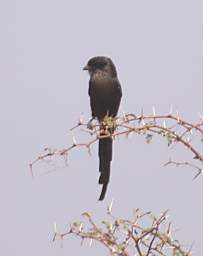 |
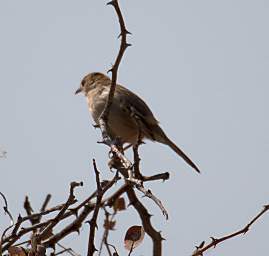 |
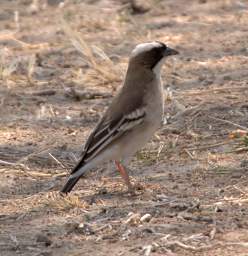 |
| Xxx Magpie Shrike | Xxx | Xxx |
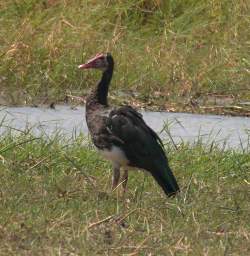 |
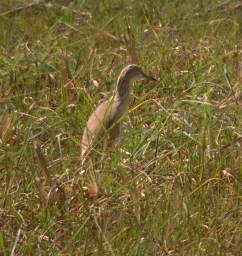 |
| Spur Winged Goose | Squacco Heron |
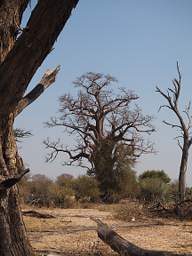 |
| Baobab |
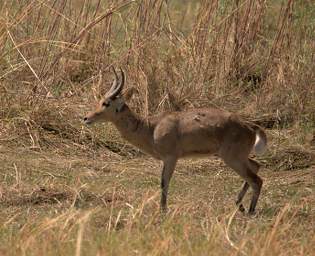 |
| Southern Reedbuck |
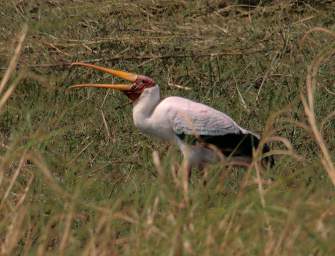 |
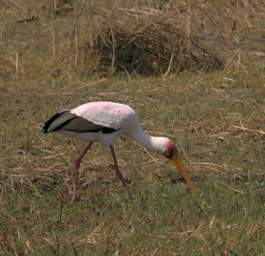 |
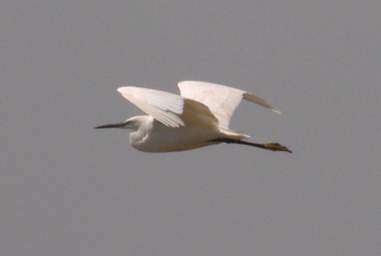 |
| Yellow Billed Stork | Little Egret | |
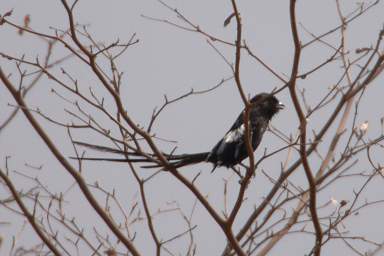 |
| Magpie Shrike |
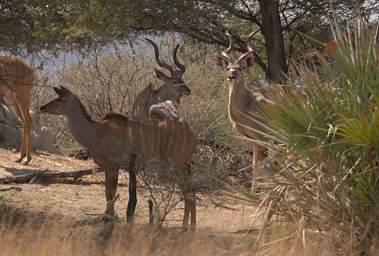 |
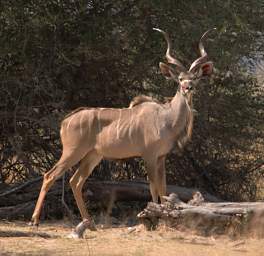 |
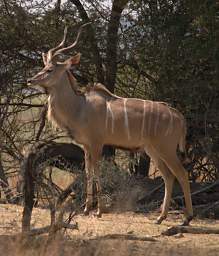 |
| Kudu | ||
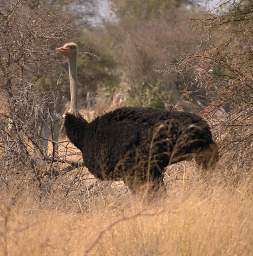 |
| Common Ostrich |
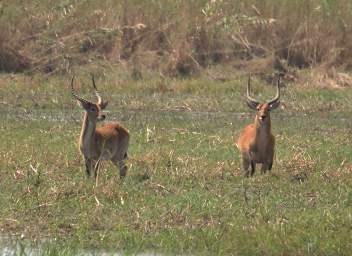 |
| Lechwe |
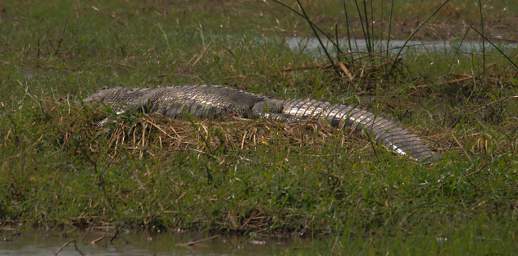 |
| Crocodile |
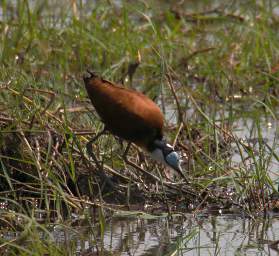 |
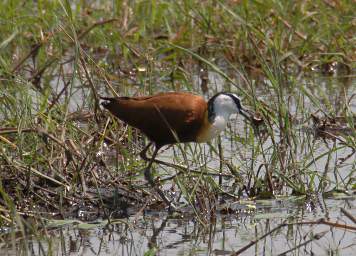 |
|
| African Jacana | ||
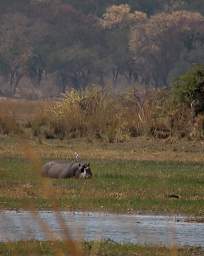 |
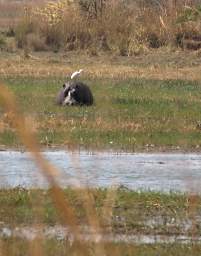 |
| Hippo | |
We were on our way back north, heading out of the park, when we stopped to view a herd of Hartebeest. It was a hot afternoon, and we were a bit bummed -- we hadn't seen any Sable Antelope.
Then, much to our delight and amazement, a whole herd of Sable Antelope emerged from the bush and worked their way down the shallow watercourse towards us.
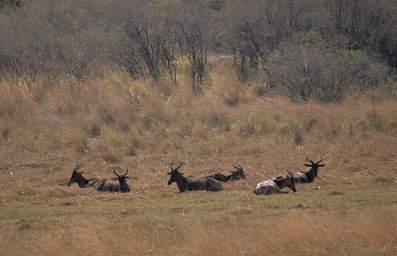 |
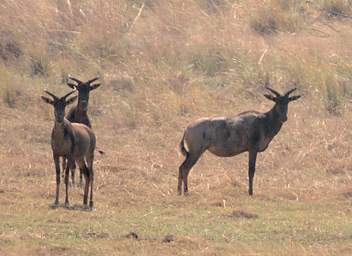 |
| Hartebeest | |
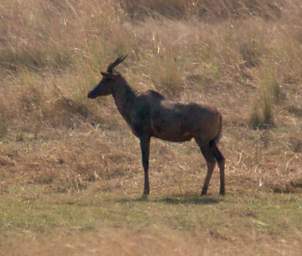 |
| Hartebeest |
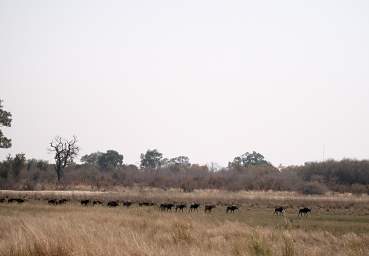 |
| Sable Antelope |
They were wary creatures, and didn't like us and our vehicle even though we were quite a ways away.
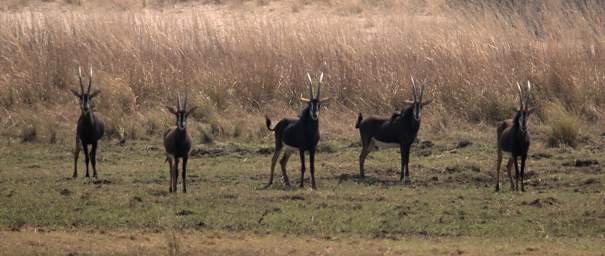 |
| Sable Antelope |
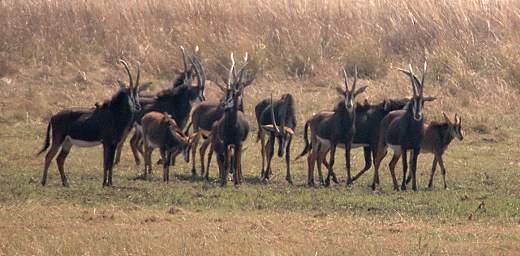 |
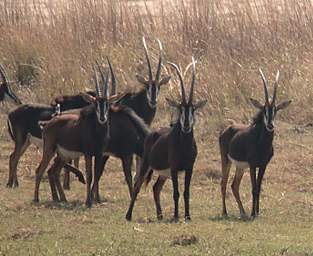 |
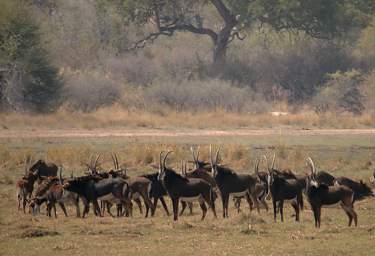 |
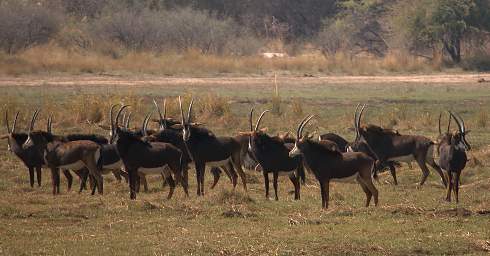 |
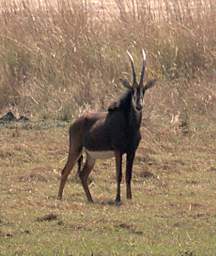 |
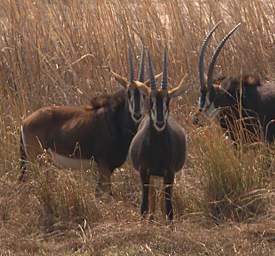 |
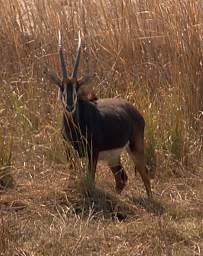 |
Some time later, a lone elephant followed the sable antelope down the swale. He had splotches of muddy clay all over his forehead; he had been cooling himself off earlier. He took his time.
 |
| Elephant |
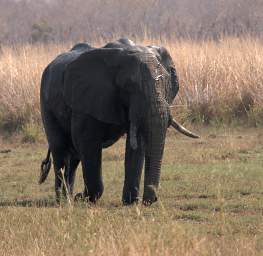 |
 |
Everywhere we went, we saw rental 4WD SUVs or trucks with camper setups. Most of the people who rent those vehicles are just going to the easily accessible places in the well-known parks like Etosha. They would be equally well served, especially in the dry season, for a lot less money in a plain old ordinary car like the one we had. But just like everyone at home has to drive a pickup truck for their testosterone satisfaction, all the tourists in Namibia rent a 4WD camper for the same reason. I got a kick out of the sign in the photo below which was on the road into Ngepi camp. We got there just fine.
 |
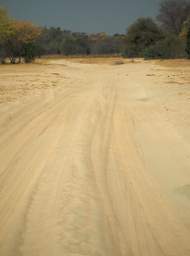 |
| Ngepi Camp Road Sign | Ngepi Camp Road |
We spent our last night in the Mahango / Okavango region at the Popa Falls Rest Camp instead of the Ngepi Camp. While we did see some new birds, we weren't nearly as pleased with the place itself as we were with Ngepi Camp. The campsites at Ngepi were much nicer, being right on the river. The Ngepi camp felt much more like a camp in the wild; Popa Falls feels like a week-end commercialized state park. It has way too much concrete and steel for me. We had dinner at the fancy restaurant, and both the food and the service were ... less than stellar.
The one redeeming factor for Popa Falls are the island habitats, but unfortunately they are in the process of building fancy mini-houses all over them to rent to tourists.
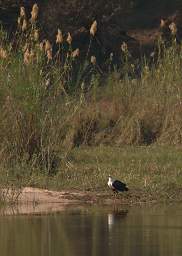 |
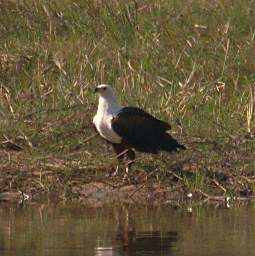 |
| African Fish Eagle | |
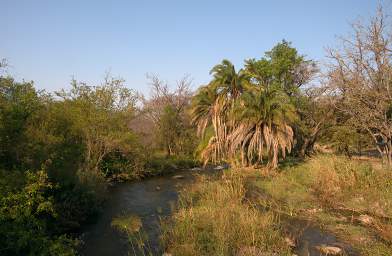 |
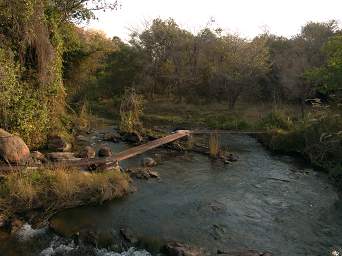 |
| Island Habitat at Popa Falls Rest Camp | Walkway to one of the islands |
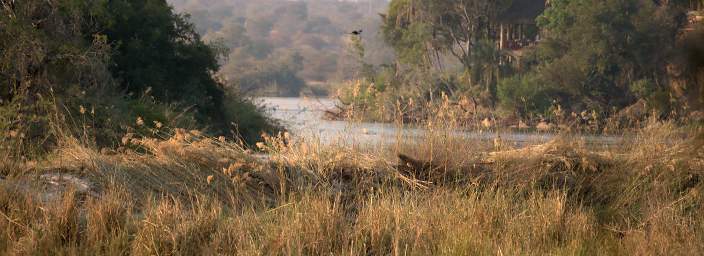 |
| Near Popa Falls |
There's a sterile-feeling bar on the bank of the river just below the falls, and a pontoon boat you can buy a ticket on to take you for a ride down the river and back.
 |
| Popa Falls from the Bar |
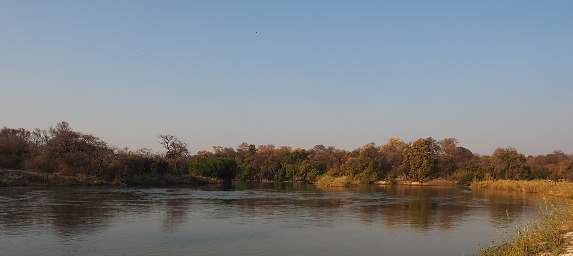 |
| Okavango River below Poppa Falls |
Some of the local people were harvesting something on the island across the river from the bar. There were several women cutting something and bundling it up on the bank, and then after a while a guy would paddle a dugout canoe over to pick them up and haul them and their harvest back to the main bank. They would also gather what looked like firewood and bring it back.
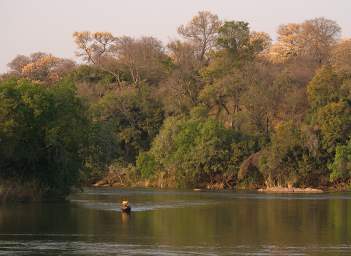 |
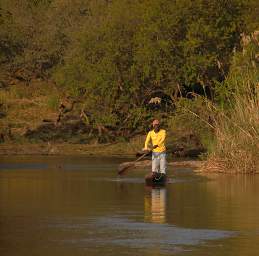 |
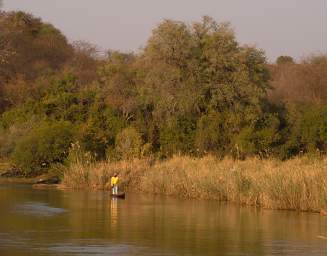 |
| Man In Boat | ||
 |
| Man In Boat |
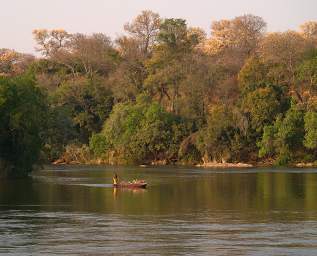 |
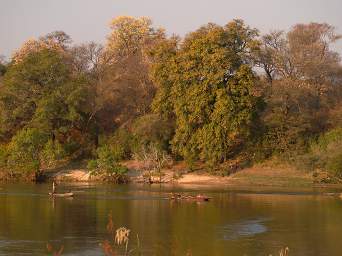 |
| Man In Boat | Men In Boats |
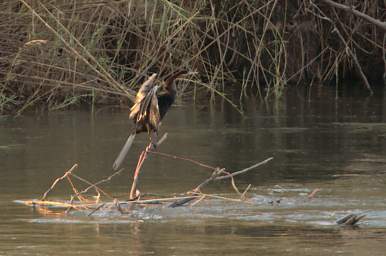 |
| African Darter |
 |
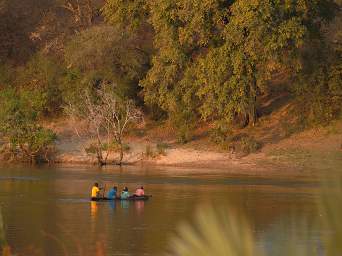 |
| Boy Ferrying Women Across River | |
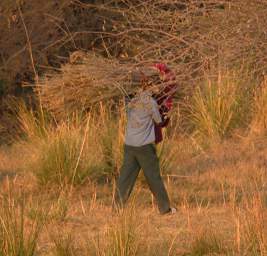 |
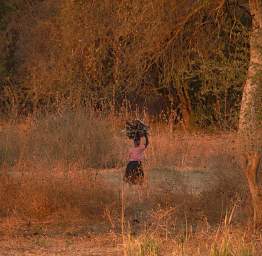 |
| Man Carrying Millet | Woman Carrying Firewood |
Our big treat was seeing a Giant Kingfisher. Unlike most species, in this one the female is the most colorful.
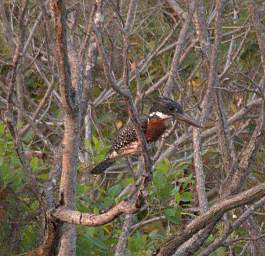 |
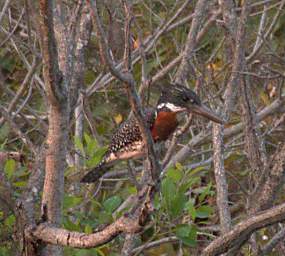 |
| Giant Kingfisher | |
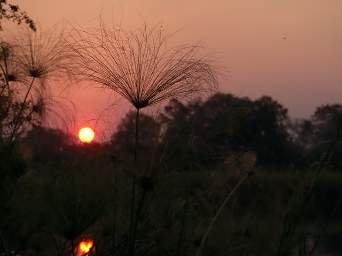 |
| Sunset at Popa Falls |
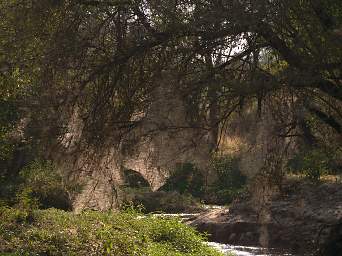 |
| Spider Webs |
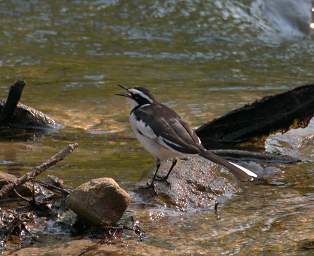 |
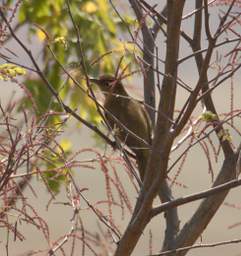 |
| African Pied Wagtail | Xxx |
We left Popa Falls and the Caprivi Strip and headed back west. We were headed for Damaraland and the Skeleton Coast, by way of Etosha National Park. It was more or less in the way and we figured we'd drive through again and see what we could. But a half-hour or so after we got started, I asked Dona about "the basket lady." Dona makes pine-needle baskets, and had been hoping to talk with women in Namibia who were basket-makers. We'd looked all over and come up empty. But when we had been at Huab Lodge, Suzie Van de Reep had told us about a woman up along the Okavango River who was helping the local women market their baskets. According to Suzie, she was the person to see if you were interested in baskets. She was somewhere near the main highway, about 100 km East of Rundu. Dona dug around in her notes and found the woman's name and instructions to where she was. As I was driving she read "turn off at Shinyungwe"... I slammed on the brakes; we had just passed a sign that read something like that. But then a lot of the names look and sound alike if you aren't very familiar with the language. I wasn't, and the odds weren't too good. But we were kinda around 100 km East of Rundu. We turned around and sure enough, that was it. We turned off and went looking for Charlie Paxton and Shamvura Camp.
The main highway we had been on parallels the Okavango River; when we turned off we were heading straight towards the river. Like most places, the old road ran much closer to the river, winding along the bank and going from town to town. In short order we were at a tee in the road, and had no idea whether to go left or right. We guessed and went left. About the time we were ready to give up we passed a rutted little road heading up a hill and a worn sign pointing saying "Shamvura Camp".
We wound our way up over the hill and down to the camp, picked a likely building and knocked on the door. Dona had been hoping to find a place where the women were actually making baskets, so she could watch their technique and trade ideas. We hadn't found that, but Charlie Paxton was a delight. She invited us in and as our eyes adjusted to the light, it seemed like every surface we could see was covered in baskets. Plus there were more hanging on the walls. They were exquisitely made, with fine detail and tightly woven.
I looked to my right and the basket closest to me had a chicken in it. It looked like a pretty darn good imitation, so I poked it a little to be sure; it moved. I didn't check for eggs; I thought that might be impolite and I didn't want to start up a squawking chicken.
Dona and Charlie talked baskets, and I wandered around just looking. There was a big basket at the other end of the table with the basket with the hen in it; it was more a pot than a basket. It had a woven lid and I wanted to look inside but there was a big heavy bible sitting on it. I wasn't sure what the etiquette was about moving peoples' bibles around, so I didn't.
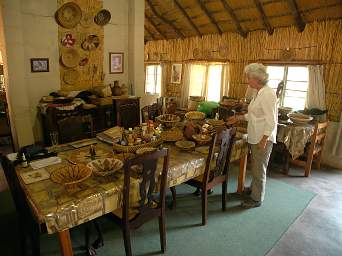 |
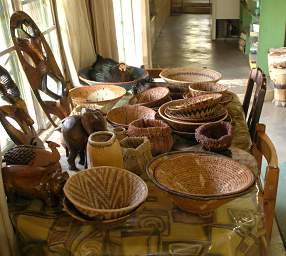 |
| Shamvura Camp, Baskets | |
I wandered outside and explored the grounds a little, enjoying the birds on the end of their long deck leading towards the river.
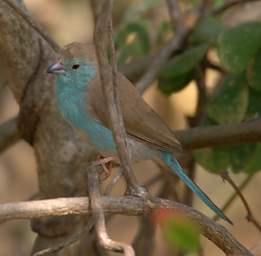 |
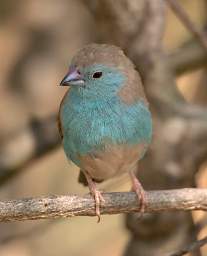 |
| Blue Waxbill | |
When I came back, Dona was examining baskets and I started talking with Charlie. One thing led to another and we ended up talking about elephant conservation and fences and she pulled up some maps showing elephant locations along the border between Namibia and Botswana. There were fences along the border to keep the elephants from trampling cropland, and you could see just be all the location reports where they were bumping up against the fences. Not good; under natural conditions they would have moved across the border and spread out.
Somewhere in there we got to talking about snakes, and Charlie mentioned that her husband Mark had caught a cobra that morning. "If he were here he would have you help him release it. It's in that basket over there." The one with the big fat bible on top of it...
Dona bought some baskets from Charlie, or rather from the women who made the baskets who Charlie was helping; and we continued on our way towards Etosha National Park.